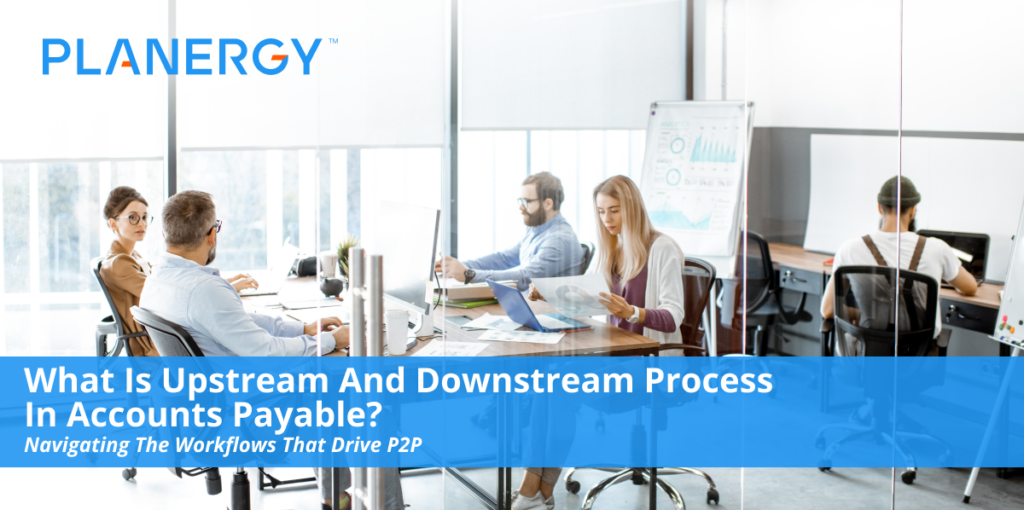The procure-to-pay process (P2P process) is the pulsing current at the heart of every business. Goods and services flow in, and payments for those goods and services flows out.
At the head of this torrent, located “upstream,” is procurement, tasked with strategic sourcing, supply chain management, and vendor relationship development. Situated “downstream” is accounts payable (AP), responsible for ensuring timely payments on vendor invoices, avoiding late fees, and, when possible, capturing early payment discounts.
Together, these two departments have the potential to create significant value as well as cost savings for the businesses they support.
Common wisdom holds that upstream processes are the primary drivers of overall improvements in efficiency, profitability, and productivity for businesses.
But not all businesses are the same, and companies looking to develop both maximum efficiency and return on investment (ROI) can also spark digital transformation and increased value generation by seeking to optimize downstream as well as up.
Ultimately, however, it is the integration of both upstream and downstream processes that holds the greatest potential for businesses looking to compete in the modern global market.
The Upstream and Downstream Process in Accounts Payable
The concept of “upstream and downstream” in accounts payable is borrowed from production, where upstream and downstream are defined as follows:
- Upstream Processes cover all activities required to collect the raw materials needed for production. This includes sourcing of raw materials, but does not include the actual processing of those materials into a finished product for sale. For example, an oil and gas company’s upstream processes would include locating the petroleum needed to produce its finished products, and extracting it using tools such as extraction wells.
Alternatively, some companies may obtain their raw materials directly from suppliers during upstream processes. - Downstream Processes cover all activities required to transform raw materials collected during upstream processes into finished products for sale. This also includes the actual sale of the goods to consumers, commercial clients, or government organizations. Direct contact with the end user is a hallmark of downstream processes. This includes not only sales, but customer service.
To continue with our oil and gas company example, downstream processes might include conversion of crude oil to gasoline, plastics, and other products, selling them to customers, and providing customer service as needed.
Things work a little differently when speaking of upstream and downstream processes in accounts payable.
In an AP context, upstream and downstream are defined as follows:
- Upstream Processes are similar to those in production. Procurement teams focus on developing and optimizing a supply chain, developing strategic sourcing policies and workflows while building competitive advantage through optimized contract management. The goal is to optimize supplier relationship management and achieve stronger competitive performance and profitability by building a framework for effective, efficient, and value-focused procure-to-pay processes.
- Downstream Processes are also similar to those in production processes, although in accounts payable processes, it’s not oil and gas being refined, but vendor invoices being reconciled and paid. And instead of being “customer-facing,” accounts payable is vendor-facing, providing important opportunities to enrich and expand vendor relationships through prompt payment, efficient processing during invoicing, and the integration of vendor data and policies with the buyer’s own procurement systems.
Working together, procurement and accounts payable can harness the potential inherent to each directional flow of resources as part of a comprehensive, value-driven business strategy.
The river of procure-to-pay can be rough sailing if you’re trying to tame it from only one direction. World-class procurement and accounts payable organizations have come to realize the importance of tackling optimization not as an “either/or” issue, but as a chance to improve from both ends and meet in the middle.
Achieving Maximum P2P Performance
The river of procure-to-pay can be rough sailing if you’re trying to tame it from only one direction.
World-class procurement and accounts payable organizations have come to realize the importance of tackling optimization not as an “either/or” issue, but as a chance to improve from both ends and meet in the middle.
In taking this approach, companies need to understand and implement three crucial modifications to their P2P processes.
1. Collaboration, Not Competition
Historically, procurement and accounts payable have been “siloed,” each pursuing their end of the P2P process without much direct interaction with the other party.
But in today’s marketplace, communication and collaboration are mandatory, particularly for companies seeking to embrace digital transformation.
By sharing information, strategizing to support shared goals, and collaborating on process improvements, both procurement and accounts payable can better contribute to the P2P process.
2. Seek Value, Not Just Savings
In days long past, procurement and AP were both regarded as necessary functions that, at best, could mitigate the expense they created by focusing on creating cost savings.
But today, CFOs recognize that the P2P process is a goldmine of potential savings and value for any organization. Streamlining the P2P process for optimal efficiency, ROI, and speed produces a ripple effect that expands to touch every area of your company, in every business unit, because how well your company handles its spend determines not just your bottom line, but your ability to strategize and make accurate, useful decisions, pursue opportunities for innovation and growth, and compete effectively.
3. eProcurement and AP Automation: A Winning Pair
Building value begins with building that all-important bridge between AP and procurement. For many companies, the keystone of this bridge is a cloud-based, comprehensive procurement solution such as PLANERGY.
Bringing together powerful eProcurement (powered by artificial intelligence) and process automation, a procurement system can help your company build value in both directions as it:
- Creates a shared, cloud-based, centralized data management solution that connects all your procurement function with AP and:
- Integrates with your existing enterprise resource planning (ERP) system, accounting software, and other tools such as customer resource management (CRM) and marketing applications.
- Makes it easy to capture, organize, review, and analyze all your spend data in real time, ensuring more accurate reports and forecasts and providing actionable insights for better decision making.
- Creates a closed system for buyers, connected to contract management, vendor relationship management, and supply chain management modules to ensure the correct information is always used and the best vendor is automatically provided for every good and service purchased.
- Eliminates maverick spend and combats invoice fraud and theft.
- Improves cash flow.
- Makes process automation a central component of every workflow, and:
- Transforms paper-based manual workflows into touchless digital ones.
- Removes human error and delay.
- Speeds every workflow without sacrificing accuracy or completeness.
- Streamlines approval workflows for both requisitions/purchase orders and invoicing, with contingencies and automatic alerts.
- Frees staff to focus on high-value tasks while ensuring data entry, three-way invoice matching, and basic vendor onboarding are still handled effectively.
- Reduces all cycle times and enables AP to capture more early payment discounts while reducing or eliminating late fees and lost or duplicate payments.
- Improves vendor relationships through clear communication, tools such as vendor portals for easy access and eInvoicing, and a collaborative approach that encourages development of strategic partnerships.
- Transforms upstream processes by providing a rich and easily accessible supply of data that makes it easier to build more efficient processes, pursue opportunities that might not have otherwise been readily visible, and develop a business strategy powered by strategic sourcing.
Don’t Just Go with the Flow—Optimize Both Upstream and Down
Smooth sailing beats shooting the rapids any day. From requisitions to invoicing to final payment, every step of the P2P process is an opportunity to improve your company’s current and future success.
And by optimizing both your upstream and downstream accounts payable processes, you’ll be able to develop better vendor relationships, capture more savings and value for your organization, and ensure both an optimal ROI and a strong bottom line.




